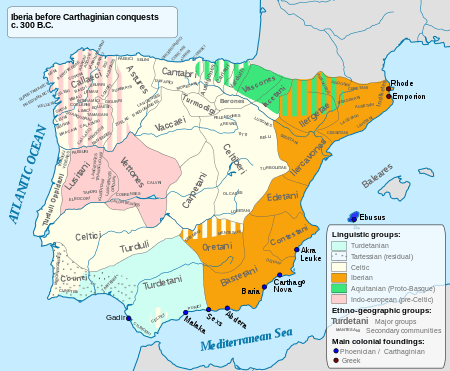Turmodigi
The Turmodigi were a pre-Roman ancient probably Celtic[1] people of northern Spain who occupied the area within the Arlanzón and Arlanza river valleys in the 2nd Iron Age.

Origins
The ancestors of the Turmodigi arrived to the Iberian Peninsula in the wake of the earlier Autrigones-Belgae migration at the 4th Century BC, which settled in the area between the Arlanzón and Arlanza rivers.[2][3] The neighbouring tribes surrounding the Turmodigi are mentioned by classic sources as being Celtic,[1] as attested by the personal name 'Tormogus' in some local ephigraphic sources.[4] Designated Turmodigi by the Roman geographer Pliny the Elder,[5] they are also mentioned in other Roman texts under the names Turmogi or Curgoni,[6][7] and in the Greek ones as Murbogoioi or Mourbogoi (Ancient Greek: Μούρβογοι).[8]
Culture
Archeology has related them with the early Iron Age ‘Bernorio-Miraveche’ cultural group of northern Burgos and Palencia provinces. Moreover, recent studies carried out at their most famed cemetery of Miraveche and as well as other 2nd Iron Age sites in the region indicates that their culture was heavily celtiberianized, demonstrating also strong affinities with the ‘Duero Culture’ of the Vaccei. In the 2nd Century BC they established a state with Segisama, also named Segisamone or Segisamum (Sasamón – Burgos; Celtiberian mint: Sekisamos) as its capital, along with the towns of Sisaraca/Pisoraca (Herrera de Pisuerga – Palencia), Deobrigula/Teobrigula (Tardajos – Burgos), Ambisna (Pampliega?– Burgos), Bravum/Bravon (Huermeces or Ubierna, in the Santibañez valley – Burgos), and Mancellus (near Lerma, in the Arlanza river valley).
History
Initially a client tribe of the Autrigones, the Turmodigi threw off their yoke with the help of the Vaccei around the early 3rd Century BC, seizing most of the former’s lands corresponding today to the central and western Burgos province and the eastern Palencia province. Like their Autrigones’ and Vaccei neighbours, the Turmodigi retained a separated identity until the later 1st Century BC, when they were first conquered and included in Hispania Citerior by Pompey and Quintus Caecilius Metellus Pius in 73 BC. However, the Turmodigi were not subdued until 56 BC, after a joint uprising with the Vaccei and other peoples was defeated by the Praetor Quintus Caecilius Metellus Nepos. Subjected to Cantabri and Astures' raids, they allied themselves with Rome during the Astur-Cantabrian wars in the late 1st century BC, even allowing Emperor Augustus’ to establish its own headquarters at their capital Segisama and turned Turmodigia into a rear base for the conquest of both Asturias and Cantabria.
See also
Notes
- 1 2 Strabo, Geographikon, III, 4, 12.
- ↑ Pliny the Elder, Naturalis Historia, III, 29.
- ↑ Strabo, Geographikon, III, 4, 12.
- ↑ D(is) M(anibus) / Phoebus / qui et Tormogus / Hispanus / natus Segisamoi / ne(!)...; in CIL VI, 24162.
- ↑ Pliny the Elder, Naturalis Historia, III, 25.
- ↑ Florus, Epitomae Historiae Romanae, IV, 12, 47.
- ↑ Paulus Orosius, Historiarum adversus paganus, 6, 21, 3.
- ↑ Ptolemy, Geographia, II, 6, 49.
References
- Ángel Montenegro et alii, Historia de España 2 - colonizaciones y formación de los pueblos prerromanos (1200-218 a.C), Editorial Gredos, Madrid (1989) ISBN 84-249-1386-8
- Francisco Burillo Mozota, Los Celtíberos, etnias y estados, Crítica, Grijalbo Mondadori, S.A., Barcelona (1998, revised edition 2007) ISBN 84-7423-891-9
- Leonard A Curchin (5 May 2004). The Romanization of Central Spain: Complexity, Diversity and Change in a Provincial Hinterland. Routledge. pp. 37–. ISBN 978-1-134-45112-8.